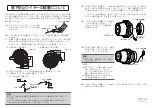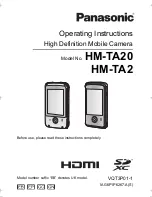XX211-21 Rev 1210 V15CCM-IR-2 Series High-Security Cell Cameras
Installation
•
5
2. Select the cable access hole in the rear cover to be used (6 provided) and knockout the hole. Place the
rear cover in the corner; using it as a template, mark the locations of the three (3) mounting holes and the
cable access hole. Remove it from the corner.
3. Drill suitable mounting holes and open the hole to accommodate routing the cables to the camera in the
wall/ceiling. Be sure the cable access hole is large enough to accommodate the cable clamp.
4. Route all necessary cables to the location if not already done so. Fasten the cable clamp (provided) into
the cable access knockout hole so that the clamp is on the inside of the rear cover. Route cables through
the access hole and through the rear cover; be sure to allow enough cable length to make connections to
the camera board. Mount the rear cover to the wall/ceiling through the 3 holes provided; use hardware
appropriate for the mounting surface.
5. Using the camera mounting frame as a template, insert it into the rear cover and mark the mounting holes
on the 3 tabs (2 holes per tab) that align with the holes in the rear cover; drill suitable mounting holes.
Attach the camera mounting frame onto the wall/ceiling and secure it using appropriate hardware for the
mounting surface. The use of No. 8 (or 4 mm metric) mounting hardware is recommended. Use hollow-
wall anchors or, if the housing is being mounted on a sheet metal surface, use rivet nuts.
6. Make cable connections to the camera board. See instructions below. Adjust the cable length as
necessary and secure the cable clamp.
Caution: Installation of the rear cover is required for Canadian UL compliance.
7. When the camera mounting frame assembly is secured to the surface, apply an epoxy security sealant
around the perimeter of the base plate assembly where it meets the ceiling/wall. [Vicon recommends
DynaPoxy™ EP1200 (US) or Arbokol 1025 (UK) or equivalent for this purpose.]
Cable Connections
All cabling is done to the boards located on the back of the front plate.
Note: Vicon systems and components, like most electronic equipment, require a clean, stable power source.
Voltage irregularities such as surges, drops, and interruptions can affect the operation of your
equipment and, in severe cases, damage certain components.
Analog Cable Connections
1. Connect the power cable to the 2-postion terminal block TB1. The camera accepts 24 VAC and polarity is
not relevant.
2. Connect the coaxial cable for video output to the BNC connector (SK4).
3. To adjust the intensity of the LED illuminators, use RV1. Intensity can be adjusted over a range of
approximately 10:1 and is at maximum when RV1 is turned fully clockwise. The factory setting is for
maximum intensity.
IP Cable Connections
1. Use the RJ-45 connector if powering the camera using PoE. If using 24 VAC, connect the power cable to
the 2-postion terminal block.
2. Video and data are transmitted via the RJ-45 connector.
3. To adjust the intensity of the LED illuminators, use RV1. Intensity can be adjusted over a range of
approximately 10:1 and is at maximum when RV1 is turned fully clockwise. The factory setting is for
maximum intensity.


















